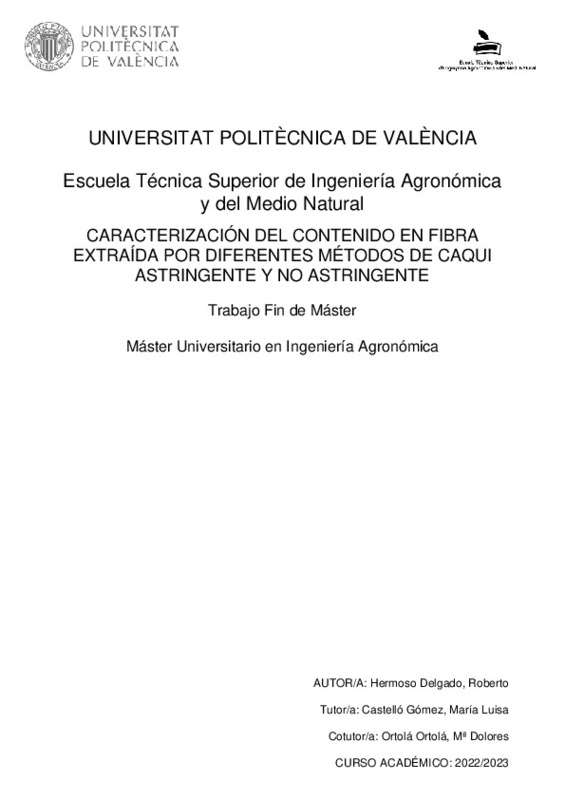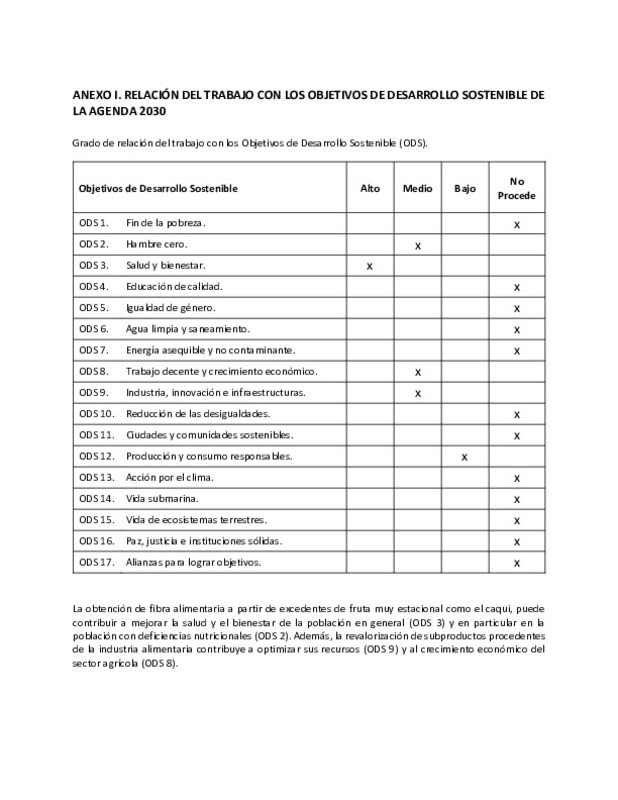JavaScript is disabled for your browser. Some features of this site may not work without it.
Buscar en RiuNet
Listar
Mi cuenta
Estadísticas
Ayuda RiuNet
Admin. UPV
Caracterització del contingut en fibra obtinguda per diferents mètodes de caqui astringent i no astringent
Mostrar el registro sencillo del ítem
Ficheros en el ítem
| dc.contributor.advisor | Castelló Gómez, María Luisa
|
es_ES |
| dc.contributor.advisor | Ortolá Ortolá, Mª Dolores
|
es_ES |
| dc.contributor.author | Hermoso Delgado, Roberto
|
es_ES |
| dc.date.accessioned | 2023-07-18T10:48:27Z | |
| dc.date.available | 2023-07-18T10:48:27Z | |
| dc.date.created | 2023-06-22 | |
| dc.date.issued | 2023-07-18 | es_ES |
| dc.identifier.uri | http://hdl.handle.net/10251/195105 | |
| dc.description.abstract | [ES] La elevada producción de caqui de la variedad Rojo Brillante en la Comunidad Valenciana, el destrío y sus excedentes, plantean la necesidad de buscar alternativas al consumo de esta fruta en fresco. Por sus propiedades funcionales beneficiosas para la salud, como su alto contenido de fibra y antioxidantes, pueden suponer una vía para la obtención de productos con alto valor añadido para su incorporación en otras matrices alimentarias. Por ello, el objetivo de este trabajo es evaluar y cuantificar el contenido de fibra total, soluble e insoluble de piel y pulpa de caqui (astringente y no astringente) obtenida por diferentes métodos de extracción (enzimática, ácida y alcalina). Para la extracción de fibra la muestra se liofilizó y molió previamente. Además, se ha analizado el color de los polvos de caqui obtenidos, así como su capacidad antioxidante y su contenido en fenoles. Los resultados indican que el contenido en fibra del caqui no depende de su nivel de astringencia y que predomina la insoluble. Además, se recomienda cuantificar la soluble e insoluble con el método enzimático y la total con el método ácido, por ser más económico. El método alcalino parece menos fiable por sobrevalorar la fibra soluble e infravalorar la insoluble. Este trabajo se ha realizado en el marco de unas prácticas de empresa financiadas por la Càtedra Catadau Agroalimentària - UPV. | es_ES |
| dc.description.abstract | [EN] The high production of the Rojo Brillante variety of persimmon in the Valencian Community, the waste and the surpluses, raise the need to look for alternatives to the consumption of this fruit in fresh. Because of its health-promoting functional properties, such as its high fibre and antioxidant content, it could be a way of obtaining products with high added value for incorporation into other foodstuffs. Therefore, the aim of this work is to evaluate and quantify the total, soluble and insoluble fibre content of persimmon peel and pulp (astringent and non-astringent) obtained by different extraction methods (enzymatic, acid and alkaline). For fibre extraction, the sample was freeze-dried and moulded previously. In addition, the colour of the persimmon powder obtained was analysed, as well as its antioxidant capacity and phenol content. The results indicate that the fibre content of persimmon does not depend on its level of astringency and that insoluble fibre predominates. Furthermore, it is recommended to quantify soluble and insoluble fibre using the enzymatic method and total fibre using the acid method, as it is more economical. The alkali method seems less reliable because it overestimates soluble fibre and underestimates insoluble fibre. This work has been carried out within the framework of an internship funded by the Càtedra Catadau Agroalimentària - UPV. | es_ES |
| dc.format.extent | 33 | es_ES |
| dc.language | Español | es_ES |
| dc.publisher | Universitat Politècnica de València | es_ES |
| dc.rights | Reserva de todos los derechos | es_ES |
| dc.subject | Caqui | es_ES |
| dc.subject | Fibra | es_ES |
| dc.subject | Astringencia | es_ES |
| dc.subject | Extracción | es_ES |
| dc.subject | Color | es_ES |
| dc.subject | Capacidad antioxidante | es_ES |
| dc.subject | Fenoles totales. | es_ES |
| dc.subject | Persimmon | es_ES |
| dc.subject | Fiber | es_ES |
| dc.subject | Astringency | es_ES |
| dc.subject | Extraction | es_ES |
| dc.subject | Antioxidant capacity | es_ES |
| dc.subject | Total phenols. | es_ES |
| dc.subject.classification | TECNOLOGIA DE ALIMENTOS | es_ES |
| dc.subject.other | Máster Universitario en Ingeniería Agronómica-Màster Universitari en Enginyeria Agronòmica | es_ES |
| dc.title | Caracterització del contingut en fibra obtinguda per diferents mètodes de caqui astringent i no astringent | es_ES |
| dc.title.alternative | Caracterització del contingut en fibra obtinguda per diferents mètodes de caqui astringent i no astringent | es_ES |
| dc.type | Tesis de máster | es_ES |
| dc.rights.accessRights | Abierto | es_ES |
| dc.contributor.affiliation | Universitat Politècnica de València. Departamento de Tecnología de Alimentos - Departament de Tecnologia d'Aliments | es_ES |
| dc.contributor.affiliation | Universitat Politècnica de València. Escuela Técnica Superior de Ingeniería Agronómica y del Medio Natural - Escola Tècnica Superior d'Enginyeria Agronòmica i del Medi Natural | es_ES |
| dc.description.bibliographicCitation | Hermoso Delgado, R. (2023). Caracterització del contingut en fibra obtinguda per diferents mètodes de caqui astringent i no astringent. Universitat Politècnica de València. http://hdl.handle.net/10251/195105 | es_ES |
| dc.description.accrualMethod | TFGM | es_ES |
| dc.relation.pasarela | TFGM\156462 | es_ES |
Este ítem aparece en la(s) siguiente(s) colección(ones)
-
ETSIAMN - Trabajos académicos [3541]
Escuela Técnica Superior de Ingeniería Agronómica y del Medio Natural







